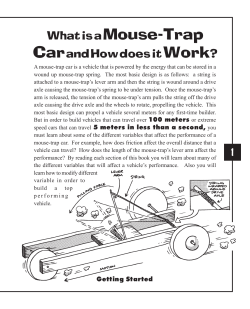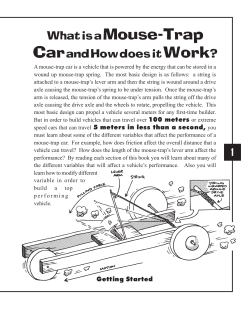
HOW TO USE THE FRICTION DEFINITION BY DOMAINS IN TELEMAC-2D?
EDF R&D LNHE BAW Karlsruhe How to use the friction definition by domains in TELEMAC-2D ? Fabien Huvelin 23.09.05 HOW TO USE THE FRICTION DEFINITION BY DOMAINS IN TELEMAC-2D? When a complex definition of the friction has to be used for a computation, the user can use this new option, which divides the domain in subdomains (domains of friction) where different parameters of friction can be defined and easily modified. Decomposition of the friction domains In this example, 7 domains of friction have to be defined. Each use different parameters of friction. The user has to do : - define the domains of friction in the mesh, - define the parameters of friction for each domain of friction, - Add the keywords in the steering file of Telemac-2d in order to use this option. EDF R&D LNHE BAW Karlsruhe How to use the friction definition by domains in TELEMAC-2D ? F.H. Page 2/6 I – Friction domains In order to make a computation with variable coefficients of friction, the user has to describe, in the computation domain, the zones where the friction parameters will be the same. For that, a code number, wich represents a friction domain, have to be allocated at each node. The nodes with the same code number will use the same friction parameters. This allocation is done thanks to the user subroutine friction_user.f. All nodes can be defined ”manually” in this subroutine, or this subroutine can be used in order to read a file where the link between nodes and code numbers is already generated (such thanks to the software JANET from the BAW used for this example, see the file *.bfr). Warning : the number of the nodes in the whole domain is not known during a parallel computation (especially when a file with the link between nodes and code numbers of domain is read) ! II – Friction parameters The frictions parameters of each friction domain are defined in a special friction data file. In this file, for each code number of friction domain : - a law for the bottom and their parameters has to be defined, - a law for the boundary conditions and their parameters has to be defined (only if the option k-epsilon is used), - the parameters of non-submerged vegetation have to bed defined (only if the option is used) Example of friction data file : *Zone *no 4 20 27 Bottom TypeBo NFRO NIKU COWH Rbo MdefBo 0.10 0.13 0.02 Boundary condition Non submerged vegetation TypeBo Rbo MdefBo Dp sp LOGW 0.004 0.002 0.12 NIKU 0.12 0.006 0.14 LOGW 0.005 0.003 0.07 9 The first column defines the code number of the friction domain. Here, there is 3 domains with the code numbers : 4, 20, 27. 9 The columns from 2 to 4 are used in order to define the bottom law : the name of the law used (NFRO, NIKU or COWH for this example, see below for the name of the laws), the roughness parameter used and the Manning’s default value (used only with the COlebrook-WHite law). If the friction parameter (when there is no friction) or the Manning’s default are useless, nothing have to be written in the column, 9 The columns from 5 to 7 are used in order to describe the boundaries conditions laws : name of the law used, roughness parameter, Manning’s Default. These column have to be set only if the turbulence model is k-epsilon (=> 3) with the option rough (=> 2) for turbluence model for solid boundaries, else nothing have to be written in these columns, 9 The columns 8 and 9 are used for the non-submerged vegetation : diameter of roughness element and spacing of roughness element. These columns have to be set only if the option non-submerged vegetation is used, else nothing have to be written in these columns, 9 The last line line of the file must have only the keyword END (or FIN or ENDE), 9 In order to add a comment in the friction data file, the line must begin a star ”*”. EDF R&D LNHE BAW Karlsruhe F.H. Page 3/6 How to use the friction definition by domains in TELEMAC-2D ? Link between the laws implemented and their names in the friction data file : No Friction Haaland Chezy Strickler Manning Nikuradse Log law of wall (1) Telemac2d numbering 0 1 2 3 4 5 6 Coolebroke-White 7 Law (1) Name for data file Parameters used NOFR HAAL CHEZ STRI MANN NIKU LOGW No parameter Roughness coeffcient Roughness coeffcient Roughness coeffcient Roughness coeffcient Roughness coeffcient Roughness coeffcient Roughness coeffcient Manning coeffcient COWH : could be used only for boundaries conditions III – Steering file In order to use a friction computation by domains, the next keyword have to be added : • For the friction data file : FRICTION DATA = YES FRICTION DATA FILE = ‘name of the file where friction parameters are defined’ • For the non-submerged vegetation (if used) : NON-SUBMERGED VEGETATION = YES • By default, 10 zones are allocated, this number can be changed thanks to the keyword : MAXIMUM NUMBER OF FRICTION DOMAINS = 80 • If the link between nodes and code numbers of friction domain is built thanks to a file : FORMATTED DATA FILE 1 or 2 = ‘name of the file’ (check that the right formatted data file is read in the user subroutine). IV – Advanced option If some domains of friction with identical parameters have to be defined, it is possible to define them only with one line thanks to the keyword : from... to... (it is also possible to use de... a... or von... bis...). The first code number of the domains and the last code number of the domains have to be set. All domains of friction with a code number between these two values will be allocated with the same parameters, except : ¾ If a friction domain is defined in two different groups, the priority is given to the last group defined. ¾ A single friction domain has ever the priority on a group even if a group with this domain is defined afterwards, ¾ If a single friction domain is defined two times, the priority is given to the last definition. EDF R&D LNHE BAW Karlsruhe How to use the friction definition by domains in TELEMAC-2D ? F.H. Page 4/6 Example of friction data file : *Zone Bottom *no TypeBo from 5 to 26 NIKU 20 NIKU 27 NIKU Rbo 0.24 0.10 0.13 Boundary condition Non-submerged vegetation MdefBo typeBo RBo MdefBo dp Sp 0.001 0.08 0.006 0.14 0.003 0.07 V - Computation without friction data file When the option FRICTION DATA is not used, some options have to be defined in the steering file because there is no friction data file in order to read them. 9 In order to use the option non-submerged vegetation without a friction data file, the next keywords have to be added : DIAMETER OF ROUGHNESS ELEMENT = XX.xxx (Ù dp) SPACING OF ROUGHNESS ELEMENT = XX.xxx (Ù sp) (The value is the same for the whole domain !). 9 In order to use the Coolebroke-White law without a friction data file, the next keyword have to be added : MANNING DEFAULT VALUE FOR COLEBROOK-WHITE LAW = XX.xxx EDF R&D LNHE BAW Karlsruhe How to use the friction definition by domains in TELEMAC-2D ? F.H. Page 5/6 VI - Programmer’s explanation VI - A ) New module A new module, FRICTION_DEF, has been created in order to save the data read in the friction file. This module is built on the structure of the BIEF objects. The domain of friction ”i” is called thanks to : TYPE(FRICTION_DEF) :: TEST_FRICTION .... TEST_FRICTION%ADR(I)%P All parameters are called : TEST_FRICTION%ADR(I)%P%GNUM(1) TEST_FRICTION%ADR(I)%P%GNUM(2) TEST_FRICTION%ADR(I)%P%RTYPE(1) TEST_FRICTION%ADR(I)%P%RTYPE(2) TEST_FRICTION%ADR(I)%P%RCOEF(1) TEST_FRICTION%ADR(I)%P%RCOEF(2) TEST_FRICTION%ADR(I)%P%NDEF(1) TEST_FRICTION%ADR(I)%P%NDEF(2) TEST_FRICTION%ADR(I)%P%DP TEST_FRICTION%ADR(I)%P%SP 1st code number of the friction domains Last code number of the friction domains Law used for the bottom Law used for the boundaries conditions Roughness parameters for the bottom Roughness parameters for the boundaries conditions Default’manning for the bottom Default’manning for the boundaries conditions Diameter of the roughness element Spacing of the roughness element TEST_FRICTION%ADR(I)%P%GNUM(1) and TEST_FRICTION%ADR(I)%P%GNUM(2) have the same value if a single friction domain is defined. TEST_FRICTION%ADR(I)%P%RTYPE(1) is KFROT when there is only one domain. TEST_FRICTION%ADR(I)%P%RCOEF(1) is CHESTR when there is only one domain. VI - B ) Programmation The link between Telemac2d and the computation of the friction (even without this new option) is done thanks to the subroutine friction_choice.f. It is used in order to initialize the variables for the option DAT FRICTION at the beginning of the program and/or in order to call the right friction subroutine for the computation at each iteration. EDF R&D LNHE BAW Karlsruhe How to use the friction definition by domains in TELEMAC-2D ? F.H. Page 6/6 Initiliazation part : During the initialization, the parameters of the friction domains are saved thanks to the subroutine friction_read.f and the code number of each nodes are saved thanks to friction_user.f in the array KFROPT%I. With the subroutine friction_init.f, the code numbers for all nodes are checked and the arrays CHESTR%R and NKFROT%I (KFROT for each node) are built. KFROT is used in order to know if all friction parameters are null or not. This information is used during the computation. Computation part : For the optimization, the computation of the friction coefficient is done in the subroutine frcition_calc.f for each node thanks to the loop I = N_START, N_END. When the option FRICTION DATA is not used, N_START and N_END are intialized to 1 and NPOIN in the subroutine friction_unif.f. Else, they take the same value and the loop on the node is done in the subroutine friction_zone.f (the paramaters used for each node can be diferent). With this choice, the subroutine friction_unif.f is not optimized when the option NONSUBMERGED VEGETATION is called (friction_lindner.f). This option aims to correct the value of the bottom friction coefficient when there is partial submerged vegetation. VI - C ) Precision When the option FRICTION DATA is not called, CHESTR can be read thanks to the selafin file. The value stored in this file are in simple precision. But CHESTR is defined in double precision. Then, the CHESTR value is not exactly the right value. Whit the option FRICTION DATA, CHESTR is set thanks to the friction data file where the value of each domains are stored in double precision. Then when a comparison is done between the method, the difference comes from this precision. In order to avoid that, it is possible to use the subroutine corstr.f in order to improve the precision of CHESTR when the friction data option is not called (thanks to the test IF ABS(CHESTR%R(I) – ROUGHNESS )< 1.D-7 THEN CHESTR = ROUGHNESS.D0, where ROUGHNESS is the roughness coefficient, but they must all be known ).
© Copyright 2025










